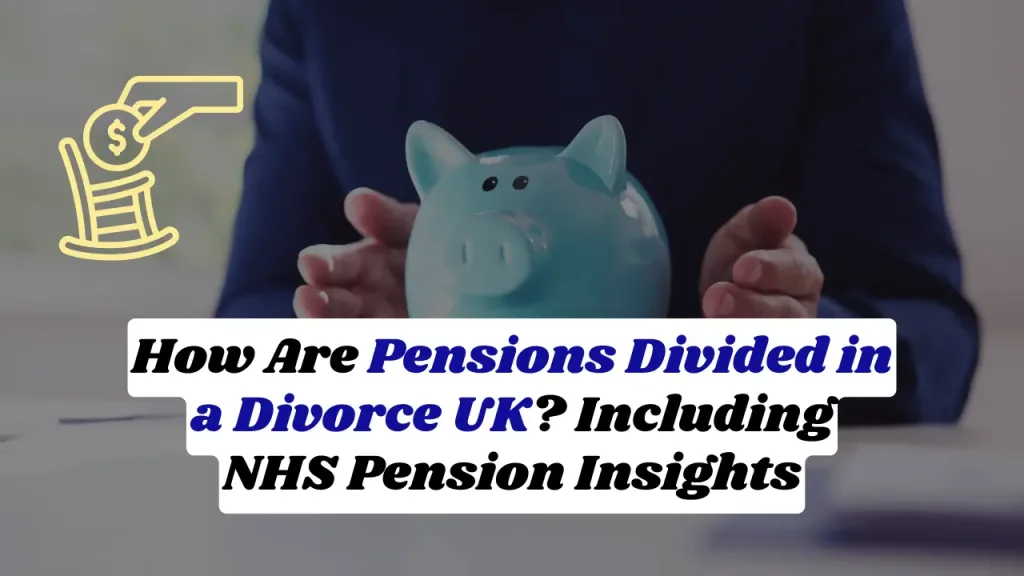How Are Pensions Divided in a Divorce UK? Including NHS Pension Insights
Dividing pensions during a divorce is often one of the most complex financial challenges couples face. Pensions are frequently among the largest marital assets, sometimes exceeding the value of the family home. Unfortunately, this critical aspect of financial settlements is usually overlooked or misunderstood, leading to inequitable outcomes. According to a 2022 study by Legal & General, only 15% of divorces include pension sharing orders, leaving many without the resources they need for retirement.
This article provides a detailed, easy-to-read guide to how pensions are split during a divorce in the UK, including legal frameworks, key options, and practical advice. Understanding the process will help ensure that your financial future is secured during and after divorce proceedings.
Table of Contents
Legal Policy: Pensions and Divorce in the UK
Under the Matrimonial Causes Act 1973, pensions are treated as matrimonial assets and can be included in financial settlements during divorce proceedings. Courts aim for fairness, often starting with a 50:50 split of all assets, including pensions. The treatment of pensions varies based on whether the divorce occurs in England, Wales, or Scotland:
- England and Wales: The total pension value accumulated by both parties throughout their lives, including contributions made before the marriage, can be considered.
- Scotland: Only pension contributions made during the marriage or civil partnership are taken into account.
The process is guided by the principle of fairness, with adjustments made to address individual needs, such as health conditions, age, or childcare responsibilities.
How Pensions Are Valued During a Divorce?
Valuing pensions accurately is critical to ensuring an equitable split. The Cash Equivalent Transfer Value (CETV) is often used to calculate the value of a pension. However, experts caution that CETVs can be misleading, especially for defined benefit schemes like those offered in the public sector.
For example:
- Defined contribution pensions (e.g., private pensions) have straightforward valuations as they represent a pot of money.
- Defined benefit pensions (e.g., NHS or armed forces pensions) require expert assessment, as the CETV may not reflect the income or benefits they provide during retirement.
To address these complexities, courts often rely on the expertise of a Pensions on Divorce Expert (PODE) or an actuary to provide an accurate valuation.

Options for Dividing Pensions During Divorce
There are three primary methods to split pensions during a divorce in the UK:
1. Pension Sharing Orders
A pension sharing order is the most common and preferred tactic as it provides a clean break between the parties. It involves transferring a portion of one spouse’s pension into a new or existing pension scheme in the other spouse’s name.
- How it works: A specific percentage of the pension is allocated to the receiving party, who becomes the legal owner of the transferred share.
- Key benefits:
- Each party has independent control over their pension.
- Death or remarriage does not affect the pension sharing arrangement.
- Example: If one spouse has a pension worth £200,000 and the other has a pension worth £50,000, the court may order a transfer to equalize the retirement funds.
Related Article For You:
What is a Pension Attachment Order in the UK and How Does It Work?
2. Pension Offsetting
Pension offsetting involves balancing pension value against other marital assets. For instance, one party may keep their pension while the other receives a larger share of the family home or other assets.
- When it’s used:
- If dividing pensions isn’t feasible due to insufficient non-pension assets.
- If a clean break is preferred without direct pension division.
- Drawbacks:
- Non-pension assets, like a house, do not provide retirement income, which could leave one party financially disadvantaged in the long term.
3. Pension Attachment Orders (Earmarking)
Under this arrangement, one spouse receives a portion of the other spouse’s pension payments or lump sum upon retirement.
- Risks:
- The receiving spouse has no control over when or how the pension is accessed.
- If the pension holder dies before retirement, the receiving spouse could lose their entitlement.
- Usage: Pension attachment is rare due to its inherent risks and lack of a clean break.
Public Sector and NHS Pensions: Special Considerations
Public sector pensions, including those from the NHS, Armed Forces, Teachers, and Police, require special attention due to their complexity. These are typically defined benefit schemes, making CETV calculations less reliable.
Impact of the McCloud Judgment
The 2018 McCloud judgment declared changes to public sector pensions in 2015 as unlawful. As a result, ongoing reforms may increase the value of these pensions, which could impact financial settlements.
State Pensions and Divorce
State pensions are treated differently in divorce settlements:
- Post-April 2016: The basic State Pension cannot be shared, but additional State Pension entitlements and protected payments can be included.
- Pre-April 2016: Couples can use their ex-spouse’s National Insurance contributions to boost their State Pension entitlement without affecting the other party’s entitlement.
Do You Need Financial Advice?
For divorces involving pensions, professional financial advice is highly recommended. The Pension Schemes Act 1993 and Pensions Act 1995 impose strict guidelines, making expert guidance crucial to avoid costly mistakes.
- If you are dealing with defined benefit pensions or public sector schemes, consulting a financial advisor or pension solicitor can help ensure fairness.
- If offsetting pensions against other assets, an actuary can assess the long-term implications to ensure equitable outcomes.
Why Is Pension Sharing Underutilized?
Despite its advantages, pension sharing is used in only 15% of divorce settlements. Barriers include:
- Lack of awareness about its benefits.
- Costs associated with obtaining a pension sharing order.
- Complexity of valuing pensions accurately.
Conclusion
Pensions are a vital asset in divorce settlements, often shaping the financial futures of both parties. While options like pension sharing orders provide a clean break, others, such as offsetting or attachment orders, may suit specific circumstances. Understanding the nuances of pension division and asking for expert advice can help ensure a fair and financially secure resolution.
By considering all legal options under the Matrimonial Causes Act 1973 and other relevant legislation, individuals can make informed decisions during their divorce. Ensuring a comprehensive financial settlement now can prevent financial hardship in the future.
About the Author

Sarah Klein, JD, is a former family law attorney with over a decade of courtroom and mediation experience. She has represented clients in divorce, custody cases, adoption, Alimony, and domestic violence cases across multiple U.S. jurisdictions.
At All About Lawyer, Sarah now uses her deep legal background to create easy-to-understand guides that help families navigate the legal system with clarity and confidence.
Every article is based on her real-world legal experience and reviewed to reflect current laws.
Read more about Sarah
